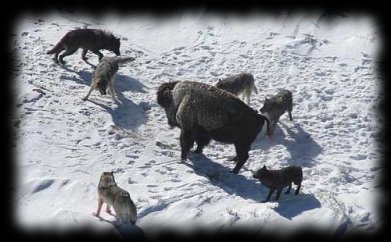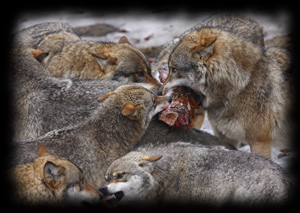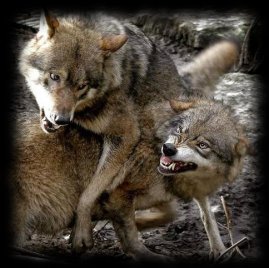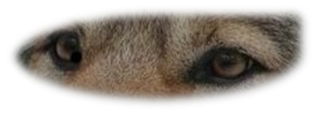The herd
The herd

Wolves are herd animals. The herd offers care, safety and the vital social contact. Every separate wolf takes in this herd another position and rank position which is dependent on its personality. This personality of the separate animal is fixed on the one hand, on the other hand it is formed by the rank position in the herd constantly. People which brought up wolves, can confirm this dynamism in a pack of wolves.
There are shy, sneaky and inscrutable wolves. Corresponding to their character and their origin the young wolves adapt themselves in the run of their development in the structure of the herd and can also change here their rank position again. As it is with people, an individual dynamism stands also out with the wolf with the classification in a group.
In the herd, the association of hunting clubs and family group of the wolf, at the first place stands the leading wolf, the alpha-dog. He has fought for this rank. He is the essential decision maker in the herd, the experienced leader, the overseers and defender, the friendly-tolerant center of the herd. The alpha-female, the most top-ranking female belongs to him in the herd. Only this female wolf receives puppies and it prevents other females to get puppies, too. The task of the alpha-female is to organize the food procurement for the rapidly growing puppies. Every additional young animal of another mother would reduce the chance of survival of own descendants. With aggressiveness and ability of getting through the alpha-female must succeed in reproducing itself only.
The other wolves of the herd follow both the alpha-animals in a gradated ranking. The herd for most of the whole wolf life - and this amounts to approximately seven years - is the preferred way of life. Exceptions are the male wolves which leave the herd at the age of approximately two years and stray in search of a life partner for the family and herd establishment. Old and the weak male-wolves which have big difficulties with the absorption of nutrients on account of the wear of the teeth and the infestation with sponges, are sometimes expelled by their herd. As a loner they are condemned to the death.
The hunting success is bigger in the herd and the chance to eat one's fill, too , because a grown wolf needs 2 to 3 kilograms of meat during the day; this corresponds to a middle deer or five deer per month. Indispensably the wolf is like a "health police" of the nature. Old and ill animals are his main food. Only if light prey is possible for him to be hunted, for example locked up domestic animals, he perceives this chance - to the big annoyance of the farmers. Wolves hit only as much prey as they need to survive and to breed the puppies. They are no killers which bring dead to everything in bloodlust. If the food offer is not so excessive, wolves also hit small animals or they are content with plants and fruits.

For every prey there is a special hunting technology. Wolves exactly know how the different preys try to defend themselves. The hunting technology is harmonized with these different defending technics. Dogs are packed in throat; the reason why hatdogs in earlier times carried a collar reinforced with sharpen iron nails. Horses are attacked frontal to escape the hoofbeats. A cow is bitten from the back in the udder. A pig is attacked mostly in twos: a wolf bites in the ear firmly, another catches the throat. Sheep are also packed in the neck. As a rule wolves hunt in the herd. Only in the group big preys can become overpowered. Single animals have only hunting success with small animals like hares or lambs.
The pack of wolves is a functional unity. The ruban it holds them together, is the mutual sympathy and respect. The basis for the living together in the herd is the ability to get in contact with each other, the communication. With the hunting maneuvers of wolves one recognizes their high apprehension and intelligence. Every wolf decides on the bases of innate and learned behavior patterns what is to be done in certain hunting situations. In seconds he estimates the reaction of the prey, calculates the state of the ground and the maneuvers already implemented by his hunting comrades. He inserts these observations in his own decision-making with which can also be the decision of the whole herd: to finish a hunt successfully or to meet decision for the break off of the hunt. The purpose of the communication with the wolf is the communication in the herd, the demarcation to other herds, but also finding of new life partners.
Wolves apply to the communication their sence of smell, the mime, the posture, the voice and touches. All these statements are elements of complex behaviors. For example, the greeting of a grown animal by a puppy looks as follows: with bent hind legs and between the legs wedged tail, only waking at the head, the puppy runs to the adult animal. The head is kept deep, the ears are put to the back. With the reaching of the old animal the puppy tries to lick the face and jump high. Besides, he squeaks pleases. Finally, he curls up on the back and whines. The puppy with this behavior simultaneously wants to express joy, submission and respect. This gesture consequence produces with an old animal a reduction of aggressiveness and a sort of nursing behavior; the close young animal makes it possible for the old animal to identify the smell and with it an additional recognition and accepting. From this moment the young animal has the charter to play with the old animal to bite it in the tail to jump, without creating aggressions. The same succession of gestures appears also then if an animal approaches which does not belong to the herd. Then it remains to the members of the herd to accept the gestures of the new animal or not.
Two most frequent contacts in a pack of wolves are the fur contact and the snout contact. They serve to exchange information about the sence of smell; touches have signal function. After fighting or after the hunt open wounds are licked, with rank fightings even from the causer of the hurts to restore the peace in the herd.

Wolves optically recognize themselves only from the next nearness. If a wolf has gone away from the herd for a longer time or if he was removed from the herd because of disobedience, an exact smell control must be carried out in addition. This is done with help of the general body odour, but also like dogs about examining Anal- and Pecaudalgland, in the high tail attempt. The sence of smell is obviously best coined with the wolf. Even if only the teamwork of hearing, face sense, sense of touch and taste sense gives the wolf his important information to survive, he owes to his fine nose many important detailed information. With the sence of smell which is connected with a specialized nervous system, the wolf can perceive complex functions of the hormone glands with all mammals, with congeners, but also with preys. The hormones whose extretion is steered by the hypophysis, or the gender glands can be identified. So the wolf can distinguish the male hormone testosterone from the feminine estrogen on the bases of the extretions. He recognizes the adrenalin produced by the adrenal gland mark or the stress hormone cortisol. All these hormones get in the sweat and so become smellable for an enemy of food , a partner or an opponent. Particularly many of these sweat glands with the wolf are in the paws where the extretions evaporate rapidly and deliver their signals of perfume in the air. For the identification of members of the family serves a genetic "smell fingerprint" which is recognized by the herd members.
For the people the own smell of the wolf, in contradiction with the smell of the dog, is only to perceived if one helds the nose directly to the fur. The preys who possess an essentially better distinct nasal organ than human, can take the weather of the wolf about long distances. Therefore wolves try to "perfume" again and again. They roll in carrion or other strongly smelling materials and then can not be identified by their preys as a wolf or enemy. To the horror of their owners many dog's races also maintain this sort of the smell deception.
Other smell information is given with the mark behavior carried out by gland extretions. This transmission of information which takes place by urine or shit mixed with gland liquid, serves about many weeks as a signal giver. More important than shit seems to be the urine. The obseved scrape in direct nearness of the urine mark emphasizes the mark also optically.
Wolves mark out with urine, however, also the territory and hunting ground which remains several years constant. Also shit is applied in addition. He always becomes set off at remarkable places on a stone, in a bush or a tree stump.
The communication in the pack of wolves also is held through voice and ear. A wolf knows six basic possibilies for giving tongue: whine, wuff, growl, cry and howling, as well as the sounds which are produced with the help of other parts of the body. A wolf communicates about short distances with body and smell signals, about long distances only with sounds. Every wolf possesses an individual timbre. In open ground wolves can communicate in distances from up to 15 kms.
However, the probably most impressive sound for persons in connection with the wolf is the howling. It has been speculated a lot about its communication function in the herd. But today one knows the possible meaning of this dreadful singing. Wolves want to comunicate with their members, to pulled apart from the herd in long distances by howling, want to know, the others are still there and want to give a signal about own point of view. Also feelings and moods can be expressed in the sort of the howling.
Wolves see relative badly. One supposes that herd members can not recognize themselves from a distance of 30 to 40 meters any more in using the face sense. The nearsightedness of the wolves is sure on the absence of the visual quarry to lead back which enables for the people to see subjects also in the far sharply. But wolves can perceive movements far away, even if only blurred. However, in the neighbourhood wolves see very well, so that mime and body language of congeners are recognizable clearly.
In the basic position the wolf has a raised body, loosens, not rigidly held legs, the tail hangs downwards, the face is smooth, the lips are relaxed, ears are moved to perceive sounds. If the situation changes and it appears, for example, a social conflict, posture and mime become a signal. Now the wolf can modify his posture and here many factors play a role to which direction his expression consequence goes. Completely essential are here his age, his gender and first of all his rank position in the herd. Then still opponents, sort of the situation, grounds and own impulse also play a role. It is essential whether it is about a competition or sexual approximating, killing of prey, fear or boredom.

A wolf which flies into a rage as a reaction to a threat, puts on the ears and shows the teeth. With increasing of the defence readiness and attack tendency the neck hairs struggle, the nose is crimped more and more and the teeth with far opened lips are shown, the ears are set up. If the wolf receives fear, the ears are put on, the eyes are wide opened and the mouth is opened, the teeth, besides, however, are not shown.
But this mime not always appears with fear or rage and aggressiveness, stated on the contrary Erik Zimen. Within a herd it sometimes comes to rank battles. In these cases it is attacked without previous signalling. There are no shown teeth, no rage face, no struggled neck hairs, no rigidly upwards held tail, no growling, but an attack from the neutral attitude and without preliminary warning.
Then with superiority of the opponent it comes visibly to appeasement gestures how the tail between the legs are stuck, the legs bend, the subjection gestures how lay on the back and whining and, finally, to the flight. Coupled with these behaviors is the look turned away in each case of the opponent who represents an expression of insecurity and fear. If the attack tendency increases, however, with missing fear, the back hair struggles, attitude and movement are loose on the contrary. The motivation to the attack is recognizable exclusively in the behavior, but not in the mime, stated Eric Zimen. According to the difference in rank which is recognized by the involved wolves very quickly, the most different steps of aggression and dominance are to be seen.
Only in few cases of aggressive confrontation it can come to battles between wolves. Because wolves live mostly under extreme conditions, hurts could mean the death. It seems meaningful not to hurt itself in a rank battle. This behavior was called by the behaviourists up to now as a "inhibition to bite". This inhibition should prevent female-wolves in biting their puppies while transportating them as well as difficult hurting in battles between wolves. Also here Eric Zimen with his observations has brought in some light in the darkness of the theory with his she-wolf Anfa. Zimen has recognized that the inhibition of biting is an individual reaction of experience of the wolves that a bite hurts and one is only bitten violently if one himself has firmly bitten. Therefore wolves refrain from biting as a rule, because they fear to be bitten painfully, too. If, however, a battle with bite takes place, own interests are at stake here, possibly with a struggle for power around a pre-eminence or alpha-position in the herd or with the eviction of animals foreign to the herd. In these cases it can also come for deadly violations.
To find new partners or food wolves sometimes must perform very long migrations. If a herd walks, the herd members usually follow the alpha-animal. They closely remain next to each other and try to set own step in that of the foreman. So a pack of wolves has often only a trace which mediates for an untrained viewer that it only comes from a single wolf. Wolves move with this method, for example, in the snow forces-saving forward and they also still have the close contact with the wolf in front. Wolves must often put back several hundred kilometers to find a new district or a new partner.
Newer researches support more and more the acceptance that the pack of wolves represents rather a matriarchy with which the alpha-females crowd male around itself which are required as a begetter, defender and bringer of food for the puppies. However one may see whether the wolf lives in a matriarchy or patriarchy, it depends very much on the personality structure of every involved animal which takes over the guidance in the herd.
© Alaskan-Malamute.ch


